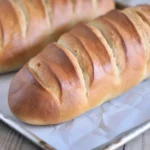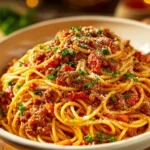french bread recipe always sounded like something only fancy bakers or Parisian grandmas could nail, right? Been there. But honestly, you just need a bit of time, your regular old kitchen, and basic stuff from the pantry. If you’ve ever felt the stress of a failed loaf (my first one? so flat, it looked like a pancake’s sad cousin), you’re in the right spot. Stick with me—after you master this one, you’ll want to try my cozy banana banana bread recipe or jump into this truly easy bread machine recipes italian herb and cheese bread. 
Table of Contents
Making French Bread Dough
Don’t let dough scare you, okay? The magic of homemade French bread starts with the simplest ingredients. I promise you don’t need fancy flour or gadgets. Grab some warm water (not hot, not cold), active dry yeast, a little sugar for the yeast to munch on, a sprinkle of salt, and regular all-purpose flour. That’s it.
Mix up your warm water and sugar, then toss in the yeast. Let it get bubbly. If it just sits there like a lazy frog, your yeast might be old—grab fresh stuff. Add in your flour and salt, a bit at a time, and start mixing. Don’t worry if it’s sticky first; it sorts itself out. Knead for about 7 minutes. Or until your arms feel slightly heroic. The dough should end up soft but not super gluey. Yup, you’re basically halfway to the best “french bread recipe” experience, and your house is gonna smell five-star unreal.
I always wondered why pros rave about kneading, but it really matters. The more elastic, the better the bread. Don’t skimp out here. 
“I never thought I could pull off baking French bread at home, but this method was foolproof. My family devoured both loaves before dinner was even done!” – Jane, loyal reader
Two Methods for Dough Rising
Alright, so your dough’s all kneaded, maybe a little sticky between your fingers but not a mess. Here’s the crossroads where people freak out: the rising. You’ve got options, honestly.
Traditional method? Plop that dough in a lightly oiled bowl, cover it up (I use a clean towel because I always lose plastic wrap), and stick it in a warm, draft-free corner. Two hours is pretty standard. It should double up in size, and if your kitchen’s chilly, give it more time. No shame.
But—life happens. If you need bread fast, crank up your oven just for a couple minutes (like, the lowest setting for maybe 2-3 minutes then turn it off), and let your dough rise in there with the door cracked. It’ll puff up fast. Just don’t forget it’s in there! This shortcut’s been my savior on busy days.
My wild tip: If you want a slightly tangier flavor, let your dough chill overnight in the fridge for the first rise. The flavor’s kinda ridiculous—makes this french bread recipe taste like a pro did it. 
How to Shape French Bread Loaves
Time for the bread to look, well, French. This step’s always made me feel like a real baker, I won’t lie. Take your dough, punch it down (so satisfying), split it in two, and roll each into a long-ish log. Not too skinny—you want them hearty.
Press with your palms, then start rolling from the center out until you get a shape you like. It’s cool if they aren’t perfect. Jagged edges? Totally fine. Place the loaves, seam-side down, on a baking sheet lined with parchment. I’ve even dusted the sheet with a bit of cornmeal if I was feeling ~extra~.
Now for “the slashes”—those iconic bread cuts. Use a sharp knife or even kitchen scissors if you’re struggling. Three or four diagonal slashes makes your loaves look classic and lets steam escape (science, right?).
If you mess up the shapes or the cuts? No big deal. They somehow puff up and still end up looking rustic. That’s what french bread recipe does. 
Baking Tips
You’ve almost made it. Here’s where the real bread magic happens.
Let your loaves rise again for maybe 30-45 minutes, uncovered. Your patience will be rewarded, I swear. Preheat your oven to 375°F. Want a glossy crust? Brush with water or a smidge of melted butter. For that super crunchy outer shell, put a small pan of water in the oven—steam is your friend.
Bake until golden brown. Tap the bottom and if it sounds hollow, it’s ready. If you like even crunchier crust, broil the top for maybe 1-2 mins at the end, but watch it like a hawk! Nothing sadder than burning your hard work at the last minute.
My favorite test? Just rip off a chunk (seriously, don’t wait to slice). If it’s warm, chewy, and smells like a bakery, your french bread recipe was a wild success.
Ingredients and Substitutions
You don’t need anything fancy, but here’s how I usually make it—and a couple swaps:
- 2 and 1/4 teaspoons active dry yeast (packets work fine)
- 2 cups warm water (not too hot or you’ll kill the yeast)
- 1 tablespoon sugar
- 2 and 1/2 teaspoons salt
- 5 cups all-purpose flour (sometimes I sub in 1 cup bread flour for more chew)
That’s it! If you’re out of sugar, honey works. No active yeast? Try instant yeast but cut the proofing time down. Gluten-free flour works, but the texture’s not the same. I’ve tried it for a friend—not quite my thing. If you’re feeling wild, toss in herbs or cheese (kinda like that easy homemade focaccia bread recipe), but honestly, classic is king.
Serving Suggestions
- Pair with homemade the best easy garlic bread recipe for next-level meals.
- Perfect with soup, chili, or literally just butter (I do this embarrassingly often).
- Use leftovers for croutons or bread pudding (trust me).
- Breakfast toast? This bread makes eggs seem like a treat.
Common Questions
Can I freeze this bread?
Absolutely. Just let it cool, wrap tight, and pop it in the freezer. It’ll last about a month. Thaws great in the oven.
Why isn’t my bread rising?
Yeast is usually the culprit. Make sure it’s fresh and your water isn’t too hot or cold. Sometimes, a chilly kitchen can slow things down.
Do I need a fancy mixer?
Nope. Mix and knead by hand. It’s a workout, but super doable.
Is all-purpose flour okay?
Yes honestly! Bread flour gives more chew, but AP flour works and gives a softer crumb.
How do I keep my crust crispy?
Leave it out (not in a plastic bag) after it cools. For extra crunch, reheat in the oven for a couple minutes.
Go Bake Some Bread Already!
Alright. You’re fully armed to make this easy homemade french bread recipe in your own kitchen, no chef hat required. Fresh, warm bread beats any store loaf—yup, even the ones behind the bakery counter. Once you’ve mastered this, you might even want to experiment with some other awesome breads like quick and easy one hour bread recipe or treat yourself to a sweet twist with hawaiian sweet bread machine recipe.
Need more? Check out this stellar Easy Homemade French Bread Recipe | Mel’s Kitchen Cafe, or grab tips from The BEST Homemade French Bread Recipe – I Heart Naptime, and peep this super clear French Bread Recipe (Easy Homemade!) – Chef Billy Parisi. Promise, nothing’s quite like pulling a golden loaf out of your own oven for the first time. Go for it—bread bliss awaits. 

French Bread
Ingredients
For the Bread Dough
- 2 and ¼ teaspoons active dry yeast Packaged yeast works fine.
- 2 cups warm water Should be warm, not hot.
- 1 tablespoon sugar Can substitute honey.
- 2 and ½ teaspoons salt
- 5 cups all-purpose flour Can substitute 1 cup with bread flour for more chew.
Instructions
Making the Dough
- Mix warm water and sugar together, then add active dry yeast and let it activate until bubbly.
- Gradually add in flour and salt, mixing until combined. Knead the dough for about 7 minutes until it’s soft but not sticky.
Allowing the Dough to Rise
- Place the kneaded dough in a lightly oiled bowl and cover it with a clean towel. Let it rise in a warm, draft-free area for about 2 hours, or until it doubles in size.
- Alternatively, you can turn on your oven to the lowest setting for a couple of minutes, turn it off, and let the dough rise in there with the door cracked for a faster rise.
Shaping the Loaves
- Punch down the risen dough and split it into two. Roll each piece into a log shape.
- Place the loaves seam-side down on a parchment-lined baking sheet. Make several diagonal slashes on top of each loaf with a sharp knife.
Baking
- Let the shaped loaves rise for another 30-45 minutes, then preheat your oven to 375°F.
- For a glossy crust, brush the loaves with water or melted butter. To make the crust crunchy, place a small pan of water in the oven while baking.
- Bake until golden brown, about 30 minutes. Tap the bottom of the loaves; they should sound hollow when done.







